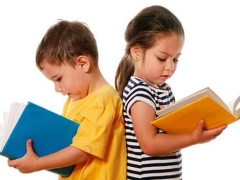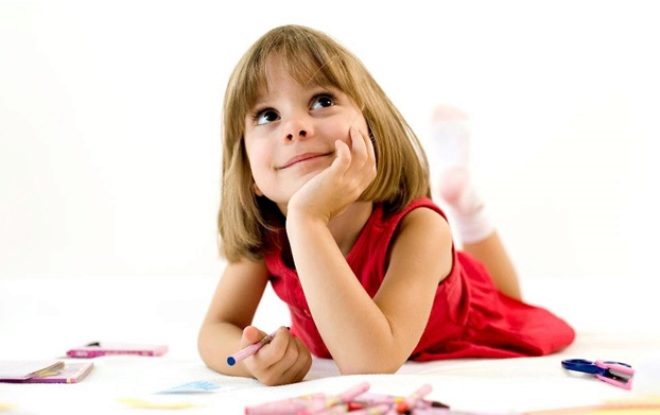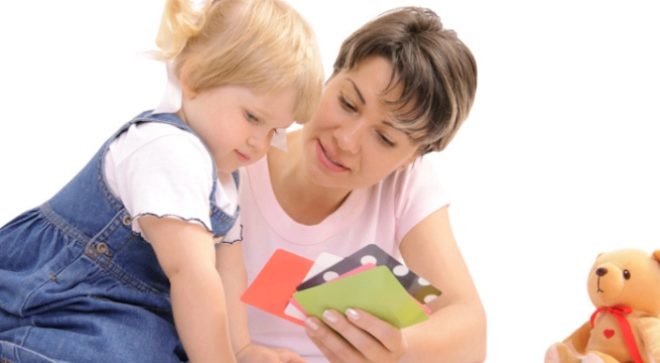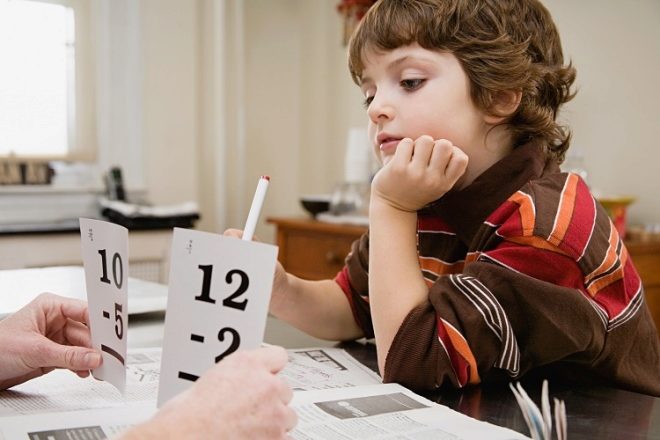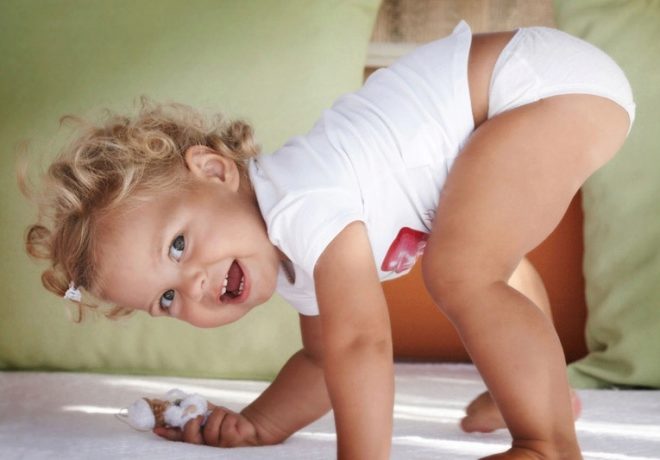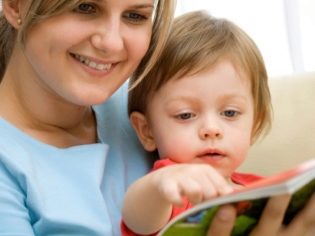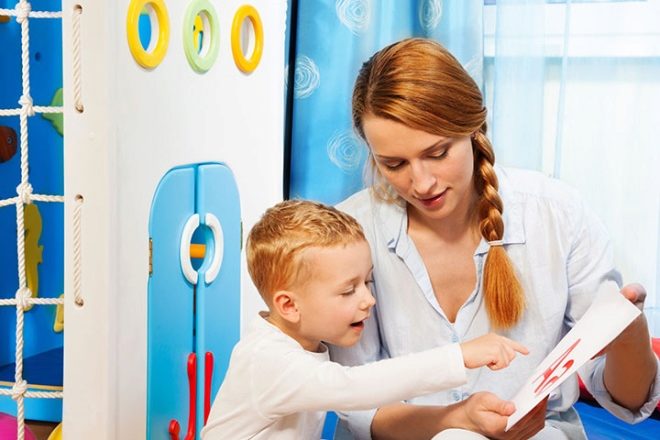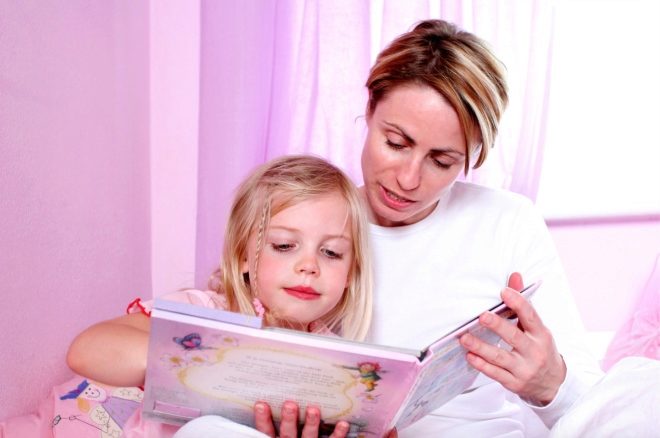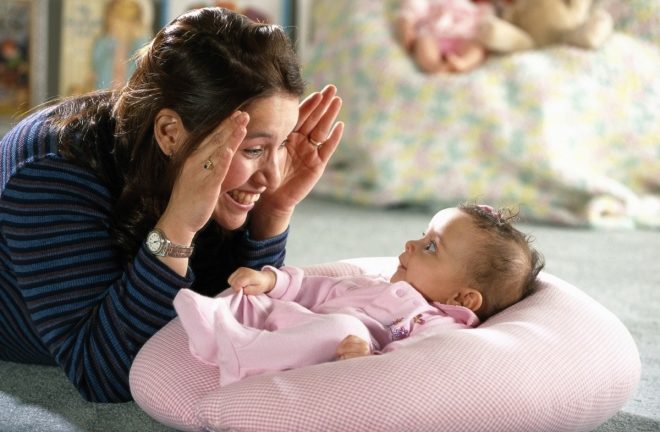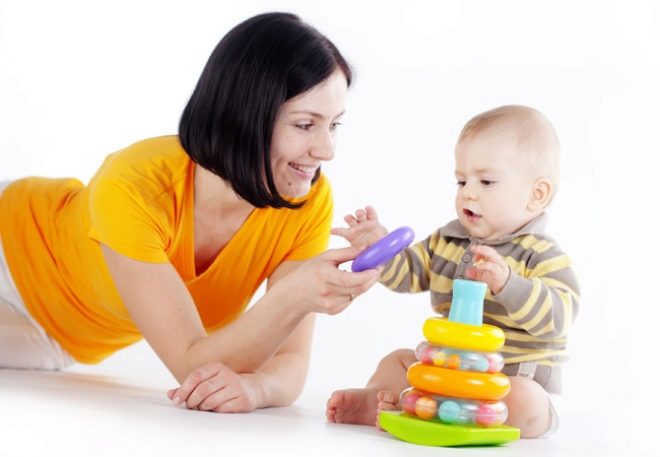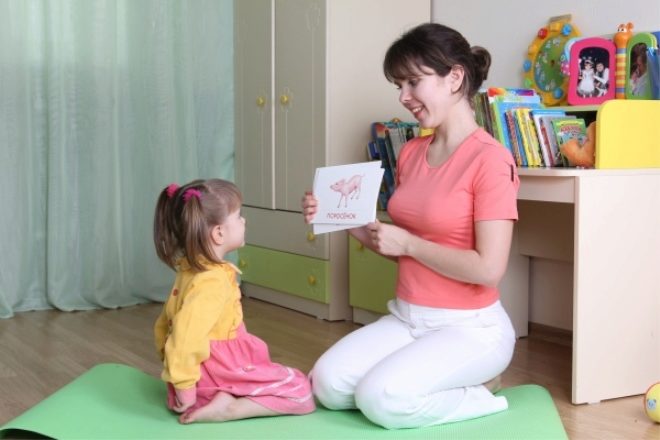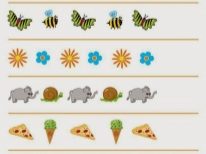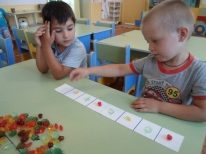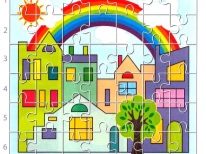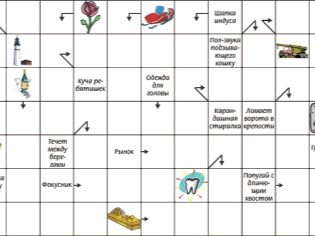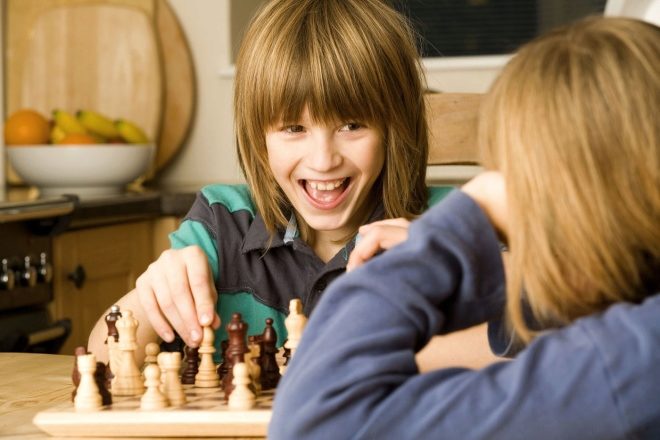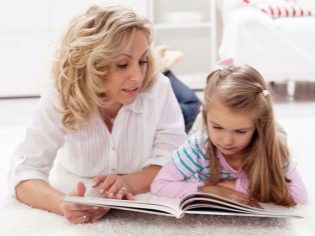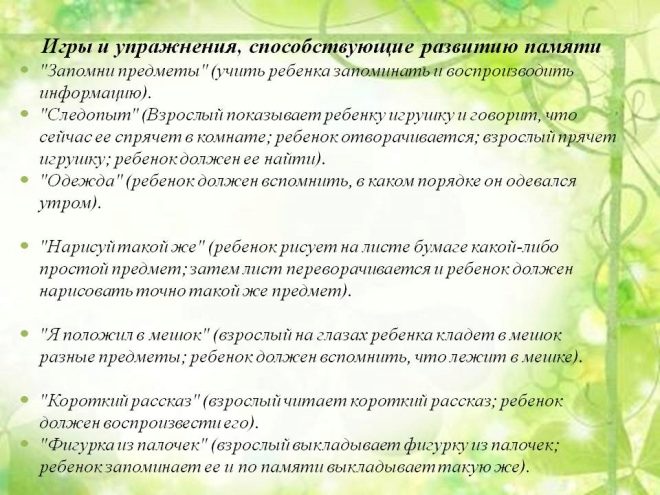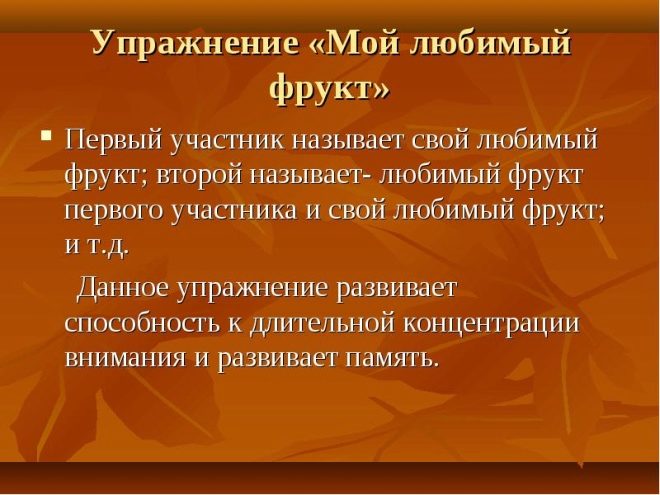How to develop a memory in a child?
“In one ear flew in, in the other flew out” - so often people talk about children who do not remember new information well. And these kids - a huge amount. Naturally, parents are wondering how to improve the memory of the child, because she will greatly help him not only in kindergarten, but also later, during school. Simple methods and techniques that will help not only make the process of memorization easier, but also have a positive effect on the child’s intellectual development will come to the aid of moms and dads.
How is the memorization process?
Memory, as an ability, is given to all living beings who are endowed with higher nervous activity. But beyond all in the ability to memorize images, information, learn advanced man. Researchers who have studied memory processes admit that there are still a lot of “white spots” in this question, but they still managed to reproduce the memory mechanism with more or less high accuracy:
- Memorization;
- Preservation;
- Reproduction upon recognition;
- Forgetting.
A child can memorize information in two ways - arbitrarily and involuntarily. In the first case, it is about memorizing poetry, which, for example, will need to be read at a matinee in kindergarten. In arbitrary memorization, motivation plays a huge role. If the baby has it, then memorization will be faster and easier.
Involuntary memorization is unpredictable. The child remembers everything that he sees, hears, and comes into contact with. However, one information remains in memory for a long time, the other quickly disappears, as a rule, as unnecessary, if a person does not access this fragment of memory, does not use it. A kid can remember a person seen on a bus for a long time only because he turned out to be similar to the character of a favorite cartoon. And your explanations of how the plumbing works, which followed the question “why”, he will forget quickly enough if the question was asked “in passing” and the information to the child was unnecessary.
When memorizing information is fixed by special "memory cells", mechanisms - brain engrams, which are also called "memory trace".
After memorization, a second process occurs - preservation. It can be dynamic and static. In the first case, we are talking about short-term memory (heard, remembered, forgotten). Static preservation is a long-term memory guarantee (heard-remembered-saved-back to saved-reworked-remembered-back). This mechanism is important for the learning process, since the child, initially remembering something important, can then again and again return to this information, which is carefully stored by the engrams, and, under the influence of new incoming information, “correct” the data, change them, supplement and expand . This is what will be the mechanism for learning the material that is important for successful learning of something.
The third important stage in the work of memory is the recognition and reproduction of previously saved fragments. OuseIt is much easier to put on what is already in memory. The child was shown illustrations of the rhyme he taught in the kindergarten — the baby begins to recall the poem itself. But if mom just asks him to tell poems that he studied more than six months ago, it will not be so easy to reproduce the information of the little one.Another memory trick will come to his aid - associations, they accompany both memorization and preservation. If the child can reproduce his own associations, he is likely to remember the text of the poem.
Forgetting is the process of releasing engrams of unnecessary information that is stored and not used. This process of destruction of neural connections is very important for the psyche of the child, which may be too overloaded if the kid does not forget something. Scientists believe that the cerebral cortex is also involved in the process of “erasing” information, “including” inhibition.
All these processes occur at the physiological, biochemical, nervous level, it involves various parts of the cerebral cortex.
Types of memory
Memory is divided into several types. According to the degree of intensity of mental processes, it can be emotional, motor, figurative (visual), verbal-logical. By the type of memorization - arbitrary and mechanical (involuntary), by the duration of information storage - short-term, long-term, operational.
The first memory that begins to develop in a newborn is motor. Motor memorization gives the baby an opportunity to learn to sit, walk, hold a toy, a spoon. Emotional memory at the very beginning of life is reflex in nature - the mother is near, the baby is calm, the mother is far away - the baby is lonely. Only by 6 months does the memorization of emotions become more conscious, and the baby can already burst into tears if he is shown a toy with which he had very painfully slapped his face the day before. At this age, the crumb knows the members of his family very well and the emotional memory makes this recognition possible - he sees his mother and smiles, he will not smile to outsiders.
Figurative memory is formed in children closer to 1 year. It is not only the memorization of the taste, tactile, visual plan, but also the creation of associations associated with it. It is through this memory that the child forms his ideas about the world. Verbal-logical memory will enable the child to formulate and reproduce their thoughts. This will be possible when the baby learns to speak at least 10-20 words.
Short-term memory for each individual child has its own volume, because it is a very individual ability, given by nature, and lasting for life almost unchanged. It allows you to perceive new information, immediately sort it and leave it only necessary. Further, the case for long-term memory. In children, long-term memorization develops at the age of about a year, for someone - a little later. RAM is needed to store temporary information, as it happens when we add two numbers in the mind (intermediate result after adding dozens, for example, we leave “in mind”).
All types of memory very closely interact with each other, without one, the functions of the others are impossible or very difficult.
Features in children
In children, all types of memory develop gradually, and this sequence is of paramount importance. A newborn at the level of motor memory perfectly remembers how to make sucking movements. By 5-6 months, emotional memory is “turned on”, and by the year - figurative. From the year a long-term memory begins to form, and the baby can already remember where he and his mother walked yesterday. The high degree of development of long-term memory will reach 2-2.5 years. The baby will build his knowledge of the world, involuntarily receiving information during the game.
At the age of 5-6 years, children usually already have a sufficiently developed arbitrary memory, and can specially memorize something, such as poems or fables, if they have motivation.
There are very interesting features of children's memory:
- Visual memory is better developed in girls than in boys.
- Motor memory develops faster in boys.
- Long-term memory used to form in girls, and, predominantly, it is emotional.
- Boys are easier to memorize numbers.
How old is it to develop?
You can develop the memory of a child from birth. At first it will be movements, and then - emotions and words. The involuntary memory of the crumb (after all, he does not try to memorize something, he does it by itself) is better trained in the form of a game, this is how the probability increases that the greatest amount of information will be analyzed by short-term memory.
In addition, it is important to remember that repetition is the mother of learning, without repetition, the child will quickly forget what you taught him.
Ways to "workout"
Improving memory is not an appropriate term when it comes to a child. Bad memory in healthy children almost never happens, it may not be sufficiently developed, and parents have to work on this.
In the diet of the child should definitely enter the vitamins, which include amino acids. Very useful fish fat, which contains unsaturated fatty acids (Omega 3 and Omega 6), if there is no allergy, you can give nuts. A child must walk a lot in the fresh air, as his brain needs enough oxygen.
There are several simple ways to develop a baby’s memory that will be useful to his parents as well, since their memory will also be trained:
- What did you do? Make it a rule to tell your child how your day went, describe all the details, and then ask your child to do the same.
- The book is the best friend. Read books to him every day, even if due to time constraints, it will be 1-2 pages, but reading should become a daily tradition.
- The game will help. Every day play with the child in words. This can be done at home, on the way to kindergarten. Give him 10 words, and ask him to name those that he can see around him (streets, lantern, bus, people, shop, dog, puddle). Visual memory is well trained with pictures. Put some images, discuss them, describe them, and then remove the 2-3 pictures and ask the child to say what is missing or who is missing. To train attentiveness will help tasks with the same pictures, in which you need to find differences, you can find them for any age on the Internet.
- Build associations. To better remember the baby, help him find an association that is understandable for him by the word or phenomenon. He will quickly begin to operate this skill.
- Music and foreign languages. Very well train the memory of lessons on musical instruments, singing, as well as learning a foreign language.
- Gadgets - fight. The Internet, the development of computer technology is already adversely affecting people's memory, it is rapidly deteriorating, because there is no need to memorize information if it can always be found in a search engine. This is not a call to abandon the use of gadgets, but parents who want to train the memory of their child should give him as little as possible to communicate with tablet and computer, and as much as possible to communicate with him personally.
Effective games and exercises
At any age, you can use a variety of games and memory development techniques. They can even come up with their own, relying on the area of interest of the growing baby. Here are just some of the games that may well become the basis for your, individual:
- For children up to 3 years. At this age, games aimed at the development of motor memory are very useful. Collect colored cubes with your child and name the colors, pyramids. Children from 2 years can be trusted to search for differences in two objects or pictures that are similar at first glance. After 2 years, it is important to begin to retell the fairy tales and poems read, ask the baby as many questions as possible, this will not only develop the memory, but also the baby’s speech. At the age of 1.5 years, you can begin to play mini-hide and seek. To do this, show him three toys, leave two, and remove one. He has to name which toy is missing.
- For children 3-4 years. At this age, special attention should be paid to the development of figurative and verbal logical memory. Frequently ask to describe a picture in words, characterize a fairy tale or cartoon character, tell what he does, what will happen to him later. It is useful to teach the child to dream. Show him pictures of animals, and then remove them and ask them to imagine that he is walking around the zoo. Call the animals that the baby saw in the pictures before, but “forget” to name one or two. Let the baby answer the question of who is missing in the zoo. Every day the number of cards with animals should increase.
At this age, the child also needs to develop a connection between different types of memory. Ask him to introduce a lemon. Let the baby tell you what color it is, what it tastes like. Then ask to describe an apple, an orange, a pear, etc.
- For preschoolers. At this age it is important to practice games that train short-term memory. Logic rows are great for this. Show the child a picture of several items in a row, then shuffle the images and ask them to return the pictures to their original position. Very well, if your preschooler learns to quickly collect pictures in parts. Take a simple image and cut it into several parts, let the child try to assemble these “puzzles” as soon as possible.
- For younger students. For a child to succeed, a child should be sufficiently developed a memory, because the amount of information that falls on him every day at school is great. It is not necessary to demand yesterday’s kindergarten to memorize everything by heart, so his short-term memory will be trained, but not long-term. Classes are best conducted in a playful way, it still remains the most acceptable for the child. At this age, it is already possible to assign a child to solve puzzles and crossword puzzles, as well as to form words into logical chains, for example, forest-stump-fungi-mushroom pickers-basket-pie with mushrooms.
- For children over 12 years old. At this age, the child has the highest ability to learn. He still perceives new information quite easily, but he already knows how to build logical connections, create images, fix them in memory. This should be used to give impetus to the new development of a teenager. It will be good if in the evening he tells in detail how he spent his day at school, with the obligatory description of his class (what color the curtains are, what is painted on them, what flowers grow on the windows. In the description of people with whom the child met it is important that parents asked as many details as possible about appearance and clothes, about facial features, about how he, according to a teenager, is good or not (it develops emotional-associative memory).
The memory of a teenager will be better if he reads a lot, learn foreign languages and play sports. And logical abilities will increase in a relatively short time if the child will play with dad or mom in chesscheckers
What are the best ways to choose to memorize poetry?
Modern school uses approaches that are aimed at the development of short-term memory-learned-answered-forgotten. Right or wrong, it's not for us to decide. The task of parents is to compensate for the gaps that exist in this school system and help the child learn to memorize and store information about what he has learned for as long as possible. Ways that we have known for a long time will come to the rescue, because most of us were told about them by our grandmothers:
- We study for the night. If there is a need to quickly learn a poem, it is best to take it when all the other lessons have already been learned, or rather, 2-3 hours before bedtime. Scientists have found out, and wise great-grandfathers already knew that the processes of memorization in the cerebral cortex take place before bedtime and in the morning, within 2-3 hours after awakening, are most active. Therefore, the verse is to teach in the evening, and then repeat it at breakfast.
- We learn in parts at the last moment. If a child reads a poem carefully only a few times beforehand, imagining as much as possible in the form of internal images everything that he is talking about, and a couple of hours before the lesson or exam that you need to memorize, reread and try to remember, the probability of remembering the entire text maximum. At the last moment, a strong motivation turns on, and therefore the process of voluntary memorization takes place many times faster.
- Learn by ear. Adults have long noticed that a child memorizes lyrics much faster than texts of stories or poems. Turn the poem into a track, read it with an expression on the recorder, and then let's listen to the child a couple of times a day - in the morning on the way to school and in the evening before bedtime. Usually memorization occurs involuntarily, but rather steadily, already for 2-3 days. If parents show the maximum of their creative abilities, then they will be able to shift poems to their favorite music of the child. So, "Borodino" can be a song on the motive of the popular rap hit, and "Sail" - a beautiful lyrical song.
- Learning on paper. You can dictate a poem to the child to be recorded by ear on a sheet of paper. Then break the work into several parts, better in meaning, and ask the child to remember the first words of each part, this will help him in time to remember what the next “piece” of the work begins with. This method, despite the longest preparations, is considered one of the fastest and most effective ways to memorize not only poetry, but also prose.
Tips for parents
Classes are not best done every day, as this may bore the child. Psychologists consider the optimum frequency - 2 times a week for 20-30 minutes (depending on the child's age).
No need to scold the child, if he forgot something, can not remember. This situation suggests that some of the stages of the memorization process was violated, you should go back to the very beginning and try again.
Each child is dominated by some one (maximum two) types of memory. One kid remembers pictures more easily, another has difficulty remembering images, but he has a well-developed tactile and taste memory, as well as a memory for smells.. Find this ability, and conduct the process of memorizing or "training" memory through its basic ability - the words in the poem can have "smell", color. If it helps the child to memorize faster, why not!
If a child of primary school age has problems remembering, teachers complain that he is absent-minded and cannot concentrate, review the child's day regimen.. Be persistent, ask to clean things in the places reserved for them, and also strictly follow the schedule of the day.
To ensure that a child achieves a good level of long-term memory as soon as possible, ask him about what he learned first, once a week, then once a month.
Your classes should be fun for both adults and children. Nothing needs to be done "under the lash." If the child does not want to study this time, do not insist. When the child gives the correct answer, be sure to encourage him, smile, sincerely rejoice in his success.
How to develop a child's memory, see the video below.
